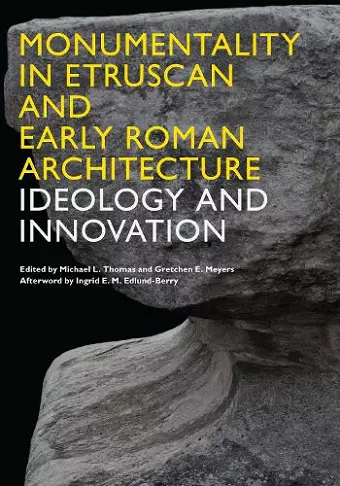Monumentality in Etruscan and Early Roman Architecture
Ideology and Innovation
Michael L Thomas editor Gretchen E Meyers editor
Format:Paperback
Publisher:University of Texas Press
Published:1st Nov '12
Currently unavailable, and unfortunately no date known when it will be back

"This volume introduces new and interesting ways to look at Etruscan and early Roman buildings in their topographical and social contexts. One remarkable aspect of the essays is their consistently high quality of scholarly content. They are well-written, interesting, and remarkably cohesive. The theories have broad applications." -- Helen Nagy, Professor Emerita, University of Puget Sound "An important contribution to the field... Many new perspectives are included, along with comparative data that offer much food for thought." -- Alexandra Carpino, Chair and Associate Professor of Art History, Northern Arizona University
Experts explore what factors drove the emergence of scale as a defining element in ancient Italian architecture, and how these factors influenced the origins and development of Etruscan and early Roman monumental designs.
Every society builds, and many, if not all, utilize architectural structures as markers to define place, patron, or experience. Often we consider these architectural markers as “monuments” or “monumental” buildings. Ancient Rome, in particular, is a society recognized for the monumentality of its buildings. While few would deny that the term “monumental” is appropriate for ancient Roman architecture, the nature of this characterization and its development in pre-Roman Italy is rarely considered carefully. What is “monumental” about Etruscan and early Roman architecture?
Delving into the crucial period before the zenith of Imperial Roman building, Monumentality in Etruscan and Early Roman Architecture addresses such questions as, “What factors drove the emergence of scale as a defining element of ancient Italian architecture?” and “How did monumentality arise as a key feature of Roman architecture?” Contributors Elizabeth Colantoni, Anthony Tuck, Nancy A. Winter, P. Gregory Warden, John N. Hopkins, Penelope J. E. Davies, and Ingrid Edlund-Berry reflect on the ways in which ancient Etruscans and Romans utilized the concepts of commemoration, durability, and visibility to achieve monumentality. The editors’ preface and introduction underscore the notion of architectural evolution toward monumentality as being connected to the changing social and political strategies of the ruling elites.
By also considering technical components, this collection emphasizes the development and the ideological significance of Etruscan and early Roman monumentality from a variety of viewpoints and disciplines. The result is a broad range of interpretations celebrating both ancient and modern perspectives.
On relèvera à cet égard que les développements d’E. Colantoni sur les mutations architecturales observées dans le Latium protohistorique et auprès de certaines peuplades américaines et africaines apportent quelques éléments de comparaison inattendus et fort utiles. * Museum Helveticum *
ISBN: 9780292756816
Dimensions: unknown
Weight: 454g
200 pages